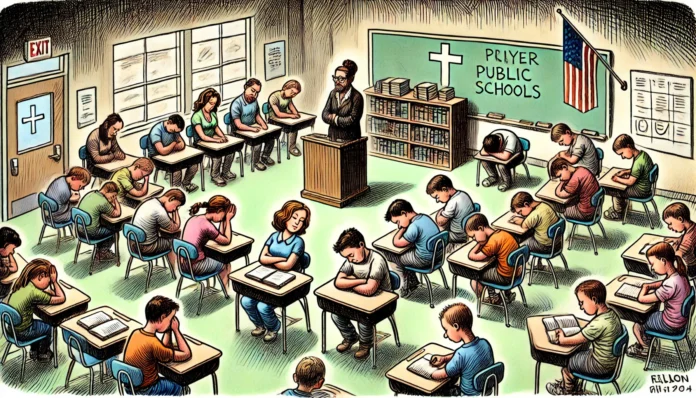Introduction: The Ongoing Battle Over School Prayer
The debate over prayer and religious activities in public schools has been a flashpoint in the broader struggle over the separation of church and state in the United States. As the nation grows more religiously diverse and secular, the question of whether—and how—religion should be present in public education remains fiercely contested. Recent years have seen renewed clashes over student-led prayers, events like “See You at the Pole,” and coach-led religious activities, all of which test the boundaries of the First Amendment. This article examines the legal background of school prayer bans, highlights recent controversies, and presents arguments from both sides, with a focus on the pro-Atheism perspective.
The Legal Landscape: A History of School Prayer Bans
The U.S. Supreme Court has long held that government-sponsored prayer in public schools violates the Establishment Clause of the First Amendment. The landmark 1962 case Engel v. Vitale declared state-sponsored prayer unconstitutional, setting a precedent that was reinforced by subsequent decisions such as Abington School District v. Schempp (1963) and Lee v. Weisman (1992). These rulings established that public schools, as government entities, cannot endorse or organize religious activities.
Despite these clear legal precedents, the boundaries of permissible religious expression in schools remain hotly debated. The Supreme Court’s 2022 decision in Kennedy v. Bremerton School District reignited controversy by siding with a high school football coach who prayed on the field after games, raising questions about the distinction between private religious expression and government endorsement.
Recent Clashes: Student Prayers, “See You at the Pole,” and Coach-Led Activities
Across the country, incidents involving prayer and religious gatherings in public schools continue to make headlines. One prominent example is the annual “See You at the Pole” event, where students gather around flagpoles to pray before school. While student-initiated and voluntary prayer is generally protected under the First Amendment, concerns arise when school staff or administrators appear to endorse or participate in these activities.
The 2025 State of the Secular States report by American Atheists highlights a troubling trend: a resurgence of efforts by Christian nationalist groups to blur the lines between church and state in public education. The report documents numerous cases where teachers, coaches, or school officials have led prayers or promoted religious events, sometimes in defiance of court orders or district policies.
Another flashpoint is coach-led prayer. The Kennedy v. Bremerton case has emboldened some school employees to push the envelope, leading to new legal challenges and confusion among school districts about what is permissible. Organizations like Americans United for Separation of Church and State have responded by providing guidance and legal support to ensure that public schools remain secular spaces.
Arguments from Both Sides: Religious Freedom vs. Secular Education
Proponents of school prayer argue that banning religious expression infringes on students’ and teachers’ rights to free exercise of religion. They contend that voluntary prayer, especially when initiated by students, is a protected form of speech and should not be suppressed. Groups like the First Liberty Institute and the American Center for Law and Justice have championed the rights of students and staff to express their faith in public schools.
On the other hand, advocates for church–state separation, including American Atheists and Americans United, argue that public schools must remain neutral on matters of religion. They warn that allowing school-sponsored or staff-led prayer can marginalize non-religious students and those from minority faiths, creating a coercive environment. The 2025 State of the Secular States report documents instances where students who opted out of religious activities faced ostracism or even retaliation.
Legal experts emphasize that while private, voluntary prayer is protected, any appearance of school endorsement risks violating the Establishment Clause. The challenge lies in drawing clear lines that protect individual rights without crossing into government promotion of religion.
The Pro-Atheism Perspective: Why Secular Schools Matter
From a pro-Atheism standpoint, the push to reintroduce prayer and religious activities into public schools is a direct threat to the constitutional principle of church–state separation. Secular education ensures that students of all backgrounds—religious and non-religious alike—can learn in an environment free from religious coercion or favoritism.
Research consistently shows that religious minorities and non-religious students are at risk of exclusion and discrimination when public schools allow or promote religious activities. The 2025 State of the Secular States report and resources from Americans United provide ample evidence of the harms caused by blurring the lines between church and state in education.
Moreover, the increasing diversity of American society makes it more important than ever to maintain secular public institutions. As the number of non-religious Americans grows—now representing nearly 30% of the population, according to Pew Research Center—public schools must reflect and respect this pluralism.
Looking Ahead: The Future of Church–State Separation in Schools
The battle over school prayer is far from settled. As Christian nationalist groups continue to push for greater religious influence in public education, secular advocates remain vigilant in defending the constitutional wall between church and state. Legal challenges are likely to persist, especially as courts grapple with the implications of recent Supreme Court decisions.
For now, the best path forward is clear: public schools must remain neutral on matters of religion, protecting the rights of all students—religious and non-religious alike.

